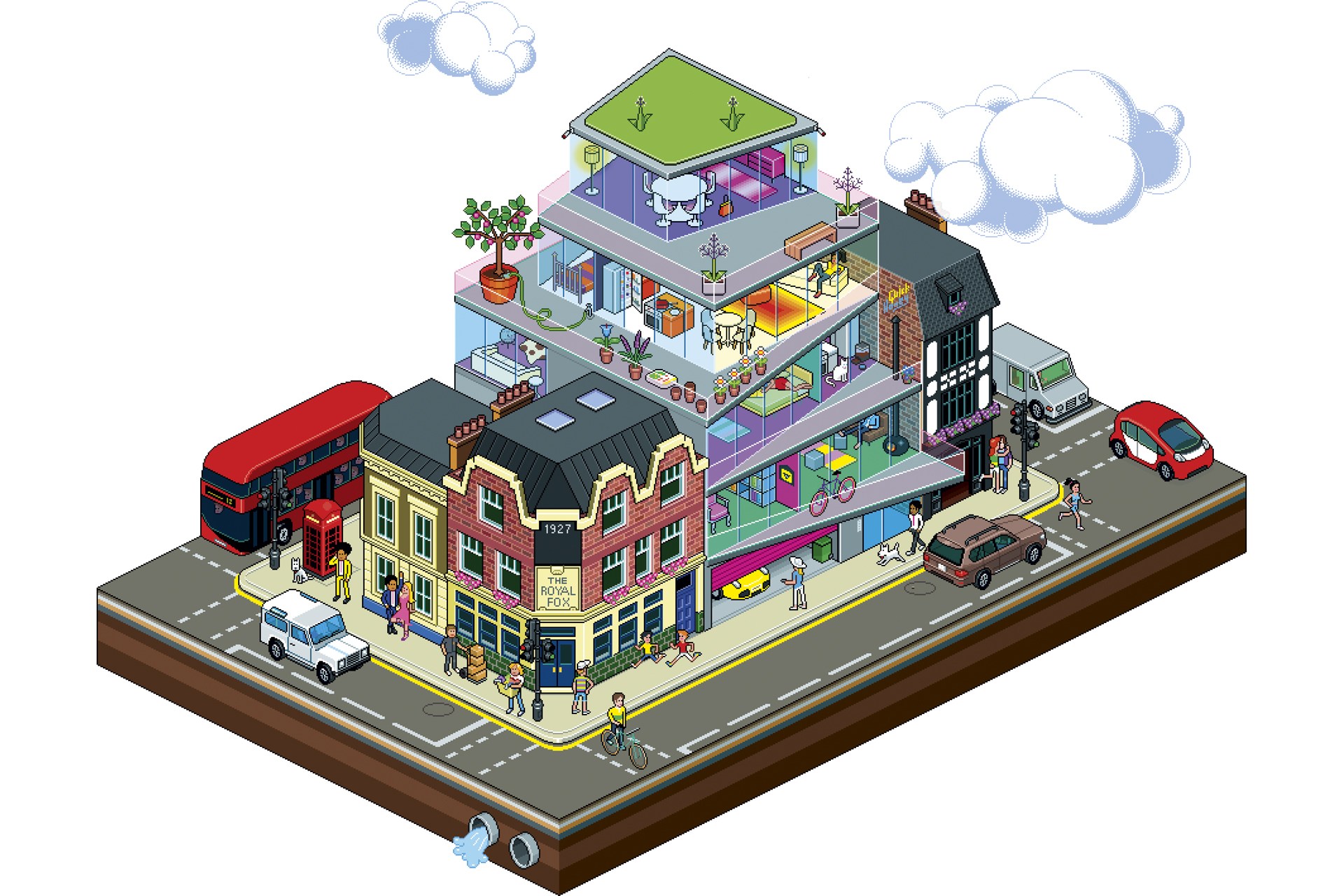The internet of things promises to transform the world. But are we risking our privacy, security and freedom?
Wired, July 2013
Last year when Sydney-resident Evan Predavec, former MD of Lexis Asia-Pacific, went on holiday to New Zealand, he decided to appoint someone to keep an eye on his house: himself. Using hardware built by Ninja Blocks, a Sydney/San Francisco startup Predavec had invested in through Kickstarter, he installed a system of switches and sensors that would allow him to turn lights on and off from his smartphone, and which would send him a snapshot of the relevant part of his home if it detected any movement.
On his return, he expanded the system to include a fan that turns on when it detects heat, and a device that sends an alert to his smartphone when the house’s side door is opened – something, he says, his son hates “as he’s always try to slip in unnoticed”. His latest project is a set of traffic lights that uses real-time data from the Sydney transit system to tell his kids when it’s time to leave the house and catch the bus to school.
By his own admission, none of this is essential kit. “It’s more just fun,” he says. But the fact that he can play around with sensors, switches and data without complicated programming or electronics suggests an important step forward for the internet of things, away from the world’s DIY hobbyists and rigid proprietary systems, towards something anyone can use to do things that maybe only they want to do. Intruder systems that connect to smartphones have been on the market for some years, but to date, no one is selling a bus-alert system based on coloured lights.
For some long-term observers of the trend, this flexibility is what will allow the internet of things to really take off. Lieven Trappeniers, head of the Ambient Media research department at Alcatel-Lucent Bell Labs in Antwerp, which has been researching the sector since 2004, sees a shift occurring away from preprogrammed systems, such as those that monitor buildings or let us track our fitness, to a world where any of us will be able to configure devices to do exactly what we want them to do.
“When the internet of things really gets established,” he says, “there will be an extremely long tail of individual devices running one solution for one person.”
For that to happen, though, three things need to change. The industry needs to agree on standards, covering not only how devices communicate with each other but also issues such as how to handle data and protect privacy. We need better hardware, especially cheaper and less power-hungry sensors and modems that can be installed anywhere and require little or no mainte- nance. And we need to develop a wide-area communications channel these devices can use, away from the cellular network, which requires relatively high-power devices – and usually a subscription – to use. As William Webb, CEO of UK-based Weightless SIG, which is aiming to develop such a net- work, puts it: “If you want your cat to have a collar that tells you where it is, you want to be able to buy a chip you can just attach to it and that’s that. You don’t want to be worrying about whether you should have a contract with O2 or Vodafone.”
Ninja Blocks was launched in 2012, having raised just over $100,000 (£66,000) on Kickstarter, to provide “the internet of things for the rest of us”. Its core kit, priced at $199, comprises a central controller (essentially a BeagleBone Linux computer connected to an Arduino), three sensors – one each for motion and temperature, and one to detect whether or not a door or window is open – and a doorbell-like button.
The sensors and button communicate with the controller using RF433 technology, the radio standard used in countless everyday devices such as car keys and wireless doorbells. The controller is connected to the internet via the user’s home’s router.
“What attracted me to Ninja Blocks,” says Predavec, “was the capacity to play with them without having toget out your soldering iron. Until recently, the internet of things was all about creating circuits and mashing them up. With Ninja Blocks you just take things and put them together, and the programming language is drag-and-drop. In minutes you can be doing something – turning on a light – whatever you want.” Adding other components, such as a camera, he says, is “pretty straightforward”.
The way Ninja Blocks components work is typical of internet-of-things applications, whether on a tiny scale, as here, or in large commercial settings such as smart-meter grids.
When a sensor is triggered, a message is sent to Ninja Blocks’ servers in the cloud. There, an algorithm decides what to do with it: in Predavec’s case sending an SMS to his smartphone, or if things are getting a little warm in the house, returning a command to the controller to switch on an RF433 remote-control electric socket connected to the fan.
Latency (the time it takes for the data to be received and a command to be returned) is potentially an issue – you don’t want an intruder, once detected, to have stepped out of sight by the time the camera takes a photograph – but most home broadband systems are fast enough to cope.
Sending texts, detecting movement and switching on fans may feel prosaic when compared with the online phantasmagoria that is the digital internet, but 20 years ago early websites were just as basic. According to Trappeniers, it will be simple tasks that will make the internet of things as much an everyday reality as the semantic or social internet today. Trappeniers’s team spent three years interviewing one of the least tech-savvy groups in the population (and one that many internet-of-things evangelists argue will be most helped by its arrival): older people with dementia.
“It was a huge challenge,” he says, “but it showed us a lot about how you can fit this into people’s lives. It’s easy to have grand visions about ambient technology, but the lessons were that the apps people wanted were down-to-earth: remind me to put the rubbish out when the bin is full; tell my family when I am not at home so they don’t worry when they call; an app to keep an eye on how much I am walking and remind me to drink water, and so on. And we found that people’s needs were very specific and unlikely to be met by broad proprietary products.”
Ninja Blocks has already started to recognise this. Recently it has started to move away from selling Lego-like kits and is concentrating instead on opening up its hardware and software to the open-source world. On the company’s online forum, about 500 developers are busy reverse- engineering existing products such as the Hue, Philips’ Wi-Fi-enabled multicol- oured LED light bulb, Belkin’s WeMo home- automation kit and the XBMC media hub. Predavec, though, is disappointed.
“I liked the fact that Ninja Blocks hard- ware was cheap and non-complicated,” he says. “It leaves a space for someone to meet the lightweight hobbyist’s requirements.”
That space may be filled by another company that also launched in 2012. SmartThings, which raised $1.2 million (£0.8m) on Kickstarter, and which has since then raised another $3m (£2m) in seed-round funding, shares Ninja Blocks’ Lego-like approach, but focuses less on servicing the maker community. Its kits, which, like Ninja Blocks’, comprise a controller and various switches and sensors, come ready packaged with names such as Home Security, Home Watch and Family Life. Unlike Ninja Blocks, however, SmartThings intends to charge customers for use of its cloud service – between “$0 and $14.99” per month depending on functionality, according the company website. (The first 10,000 customers will get free access for life.) And the kits themselves are more expensive, at $299 (£200) each for a similar amount of equipment.
For Alex Hawkinson, SmartThings CEO, the biggest difference between the two companies is how they enable individual devices in a home to communicate with the central hub. Unlike Ninja Blocks, with its reliance on the simple and ubiquitous RF433, Smart-Things products use ZigBee and Z-Wave. The two protocols have emerged as leading home-automation standards for low-power, short-range communication, and are used by thousands of off-the-shelf products from smart switches to digital televisions and air-conditioning units. Unlike RF433, both standards allow encryption and can be used to build mesh networks, in which individual devices forward data to and from other components further afield, significantly increasing a network’s range. (Pete Moore, Ninja Blocks’ CEO, says the next iteration of Ninja Blocks will include ZigBee and Z-Wave.)
However individual devices communicate with each other, they can usually rely on being near a fixed internet connection to connect them with the cloud. Nest, for example, the sleekly designed thermostat that learns users’ heating preferences and detects whether or not they are home, uses a Wi-Fi connection to communicate with the outside world. Step outside, however, and that becomes more of a challenge. So far, almost all outdoors internet- of-things devices have either had to have their own integrated modem, or rely on a nearby smartphone or on being taken home and plugged into a PC. Examples of the former include connected street-lamps (a pilot project is underway in Amsterdam) and on-street recycling bins, such as those made by US company Big Belly, which use GPRS to tell their owners when they are nearly full.
Relying on a smartphone is not necessarily a drawback. In the developed world, where the internet of things will take off first, smartphone penetration is high and still rising. Fitness-tracking devices, such as Fitbit or Nike’s Fuel Band, which come packaged with a smartphone app that does most of the thinking and connectivity for them, are selling well, and users seem happy to take their phones with them on a run. Investors see opportunities in this two-device approach too. The Pebble Watch, in effect a glorified remote control/display for an iPhone or Android device, is the highest-funded Kickstarter project to date, last year raising $10 million after pitching for $100,000.
The automotive world has taken a similar approach, though here it is easy, and virtually cost-invisible, to build a cellular device into a car. This has obvious uses such as providing the driver with information and entertainment. But it is also now being used for true machine-to-machine communication. Last September, some Tesla Motors vehicles downloaded the first over-the-air auto- motive software patch, which upgraded the engine management system of the Model S sedan. The upgrade, which took about two hours to complete, could be downloaded via the car’s built-in 3G connection or through the owner’s home Wi-Fi network. For the moment, this is a high-end option, but according to the Groupe Speciale Mobile Association (GSMA), which represents mobile operators worldwide, 90 per cent of new cars will, by 2020, have an on-board communications platform and will share data not only with car manufacturers but also with each other.
This potentially huge market has already caught the eye of the big networking companies such as Qualcomm and Cisco. Qualcomm is easily the leader in the connected-car world. Versions of its Gobi chipset – essentially small 3G/4G modems that sit under the bonnet – are already in tens of millions of vehicles across the world. And in January this year, it announced a tie-in with Audi to provide 100Mbps 4G connectivity to the Audi A3. As well as powering navigation and entertainment systems, the chip will create an in-car Wi-Fi hotspot for up to eight devices.
Cisco’s approach is slightly different. It has its eye on the complicated network of sensors, switches and cables that run a typical car. Last year, it launched its Smart Connected Vehicles unit, aiming to re-engineer the way on-board systems interconnect. Powered by a 4G modem, the Cisco approach would connect the car to the internet in the same way as Qualcomm’s Gobi device, but would also replace the chunky cables that run through modern vehicles with lighter-weight Ethernet cabling and Wi-Fi. The company says this could reduce a car’s weight by 30-40kg, lowering fuel consumption.
Thilo Koslowski, an automotive specialist at the consultancy Gartner, sees connected cars becoming an even more disruptive influence than other parts of the internet of things. Writing in US WIRED earlier this year, he argued that 4G-connected vehicles will become intelligent devices themselves, collecting data from on-board sensors and channelling it up into the cloud or sharing it with other vehicles nearby.
A connected network of cars could warn of traffic jams or spot parking spaces. It could monitor an individual’s driving and help reduce insurance premiums. And it could use mesh capabilities to create short- range cellular networks and improve the quality of in-car phone chats. (Veniam in Portugal is developing exactly this.) It may change the way we pay for cars.
It is hard for outsiders to penetrate the car industry. In a separate interview with US Wired, Koslowski warned that Cisco will to have to find its place in the existing auto- motive supply chain. But there are signs that the industry is opening up. Last year Ford announced a partnership with Bug Labs (which makes prototyping hardware) to develop an open-source connected-car R&D platform that other developers could be part of. And GM has opened up the API of its OnStar onboard navigation and communications system to a few developers.
It’s one thing, of course, to install a 4G modem in a car. It’s another to attach a smart- phone to William Webb’s cat. For that, he says, we need much tinier devices that use almost no power, and a robust and agile network for them to communicate with. “For a true internet of things to emerge,” he says, “we are going to have to develop a chipset that is very low-cost, both in itself and for sending data, with a battery life of, in some cases, ten years or more, and with access to universal coverage.” Webb acknowledges that these are tough goals but feels that certain aspects of the internet of things, as against, say, the phone network or the digital internet, could play into system designers’ hands. “Most internet-of-things messages will be very short,” he says. “Delays of just a few seconds are rarely problematic, data rates can be low, sleep times can be long, and seamless handover is not needed.”
Webb is CEO of Cambridge-based Neul, which is aiming to build such a net- work. He’s sees an opportunity in what is called “white space” in the radio spectrum: gaps between assigned frequencies, which in many countries can be used without a licence. Working with companies such as CSR, Cable & Wireless and ARM, Weightless is developing a set of standards that will allow small chips to hop between these frequencies and communicate with base stations that are themselves connected to the internet. Early prototype chips, which are being tested by companies in the smart-meter, automotive and personal healthcare sectors (Webb won’t say which), have delivered ranges of 5-50km. They run on very low power and cost less than £1.40 each. They will also be able to run for ten years without a battery charge.
“There is massive potential here for machine-to-machine communication,” he says. “Unlike, say, phone conversations, these messages will be short, maybe about 50 bytes, and we expect each base station to be able to handle tens or hundreds of thousands of them. And the big advantage is that most of the machines will know exactly when to send things. A smart meter, for example, might send a message every six hours. We can schedule these events and pack more in. It’s the difference between a plane, where people book in advance, and a train, where you don’t know who will turn up when and some are packed and others empty.”
As Wired went to press, Weightless was due to publish its first draft set of standards, and it plans to issue a revised set of chips for testing in June/July. Webb estimates that the UK could be universally covered using about 5,500 Weightless base stations. (By comparison, the mobile- phone network comprises about 35,000). And he says the group is being approached “every day” with problems coverage like this might solve.
“One, a company that works with Net- work Rail, is talking to us about a device that detects obstacles on a track at a level crossing,” says Webb. “Most of the time it will be just sending a short message: ‘All clear’. But if there is something there it can take a CCTV image, compress it and send it to the signalman to assess.”
The Weightless chip is being developed in tandem with ARM, the Cambridge- based semiconductor designer. ARM’s technology can be found in almost every smartphone worldwide and the company wants to achieve the same penetration with the internet of things.
“At the simplest level,” says Mike Muller, ARM’s CTO, “we are interested in the internet of things because we make chips and we gain if it gets big. Already, of the 8.7bn ARM chips that were shipped last year, a lot were in low-power microcontrollers. That will only increase. The challenge is to develop chips that are really low-power, truly embedded controllers, embed- ded in concrete, perhaps – a lot of these devices will be energy-scavenging. And on the comms side we need to keep devel- oping low- and medium-range protocols for low volumes of data.”
Both Muller and Webb compare Weight- less’s process now with that which gave birth to Bluetooth almost 20 years ago. Then Ericsson developed the technology and immediately made it open, bringing other manufacturers into the fold.
“We need standards,” says Muller, “but not one big standard. It’s not just a group of people, which often ends up with something top heavy and unwieldy. It’s developing the tech and getting it out there so everyone starts to use it.” Muller says early R&D work is promising but the company’s chips won’t themselves generate any data. That work will be done by sensors, either in the environment or in buildings, or, potentially much more disruptively, attached to us. According to Melanie Swan, a Palo Alto-based technology researcher and founder of DIYgenomics, which crowdsources personal health data, by 2017, 80 million wearable health sensors will be connected to the internet of things, measuring variables such as pulse, temper- ature, blood oxygen and glucose levels, respiration rates, hydration and brain activity, and sending data up to the cloud.
Devices that monitor patients’ vital signs at home and relay that information to their doctor are already common. According to Berg, a Swedish consultancy, about 2.5 million patients worldwide currently use them, a figure it expects to rise by 18 per cent each year between now and 2016. But these often use large sensors, such as wristbands, blood-pressure cuffs and electrodes adhered to the skin. Now the sector is developing chips that are smaller and which can transmit data wirelessly or via chemical signals.
One example is a tiny flexible patch developed by mc10, a Cambridge, Massachusetts-based company that has so far raised $34 million in venture funding. Containing sensors, a microprocessor and a short-range wireless device, the patch can be applied to anywhere inside or outside the body, and will transmit real-time data to a nearby receiver. The patch dissolves safely after about two weeks. A similar temporary patch has been developed by San Francisco startup Sano Intelligence, which is currently operating in stealth mode. A series of embedded electrodes samples the glucose and potassium levels of the wearer’s blood and transmits the results to almost any nearby device. Now undergoing pilot testing, the device, which is expected to retail for about $1 or $2, is due to launch this summer.
Nor do sensors have to be static. Proteus Digital Health, based in Redwood City, California, is marketing an ingestible sensor that draws energy from stomach fluids and monitors a patient’s response to medication. It encodes the results into a chemical “number” that passes through the blood- stream and is read by a battery-powered sensor on the patient’s skin.
GE, the US’s largest industrial company, is also looking to the healthcare market to build what it calls the “industrial internet”, though it is focusing on patient management rather than diagnostics. With a long track record of managing sensors in heavy machinery, the company is developing both hardware and software to link patients, beds and equipment at Mount Sinai Medical Center, New York. Each patient is given a plastic wristband that contains location and other sensors. An algorithm, designed to target patient flow and expected discharges, assigns beds and other resources in the most efficient way. Qualcomm is also developing wireless technology to enable management of patient records in the cloud.
All these extra devices, perhaps surprisingly, are unlikely to put too much extra strain on bandwidth. At ARM, Muller acknowledges that the number of messages moving around the internet will increase significantly once all these embedded chips start communicating. But, he says, most internet-of-things apps will individually produce relatively small amounts of data.
“My daughter listens to music by streaming videos from YouTube,” he says, “which she just hides in the background and doesn’t watch. That profligate use of bandwidth alone is probably more than that which will be used by all the car-parking apps in the world.”
He does warn, however, that we are not ready for the privacy concerns that will be raised by internet-of-things data. “At the moment, a lot of the internet of things is in vertical silos: you, your need and your app. But it opens up countless possibilities for sharing, and as soon as you allow people to mine data you have issues. People don’t think now about how much data they are giving away just by clicking Search. I might be happy to share my weight with my doc- tor. But my insurance company? We need to pay attention to where all this data is going.”
This is a key concern for Jaap-Henk Hoepman, associate professor in the Digital Security group at ICIS at Radboud University Nijmegen in the Netherlands. He lists three things that will need to be considered if the internet of things is not to descend into a dystopia of surveillance: privacy, trust and user control.
“In its mature form, the internet of things should be invisible,” he says. “If you do something, the environment does something. You move an object on your desk and something happens. But problems come when something is invisible and users are not in control. If I am alone at home I like to play music, but when my wife comes home I turn it down. This could be done automatically, but it would require my house being continually scanned. If this information leaves the house, you need to know what happens to it once it has been collected.” In March this year, researchers at Cambridge University demonstrated that extremely accurate estimates of race, age, IQ, sexuality, substance use and political views could be inferred from auto- mated analysis of Facebook Likes. Hoepman warns that data generated by the internet of things will potentially reveal much more.
“What is possible and knowable with the internet of things,” he says, “is far beyond what is happening with Facebook.”
For some, though, this ocean of data will itself bring about a radical change in the way we live. Rob van Kranenburg, a researcher and founder of the Internet of Things Council, a Brussels-based think tank, argues that the transparency that the sensor network will engender will disrupt the world to an even greater extent than the digital internet has already.
“The internet has given us huge transparency,” he says. “We get better deals when we buy things, and even better, we are able to lease things instead, as with Zip-car. In 20 years, the browser has turned the world, if you like, through a quarter. Now the internet of things will turn it half. And it will be transparency that will stop, say, IBM and Cisco, or Google at glasses level becoming gatekeepers and gaining all the power. A world in which there is total transparency, where everyone has access to all data, would be a garden of Eden.”
Webb is not so sure. “I don’t want other people to know that my bin hasn’t been emptied for three weeks, and so maybe I am away. Most of the machine-to-machine communication will be closed, lots of silos next to each other. It won’t be so much an internet of things as intranets of things.”
Technology writer Andrew Keen is also sceptical, but from a philosophical point of view. “We are flawed as a species and we should celebrate that,” he says. “We are going to have to create network-free zones. And we don’t need an internet fridge. We should take responsibility for replacing our milk when it runs out. In the end, it’s about deciding who we are as human beings.






